An epic Korean street food, perfect for a snack or dinner. Get your golden and crispy fried Haemul Pajeon (aka Korean Seafood Pancake) on the table in just 20 minutes!
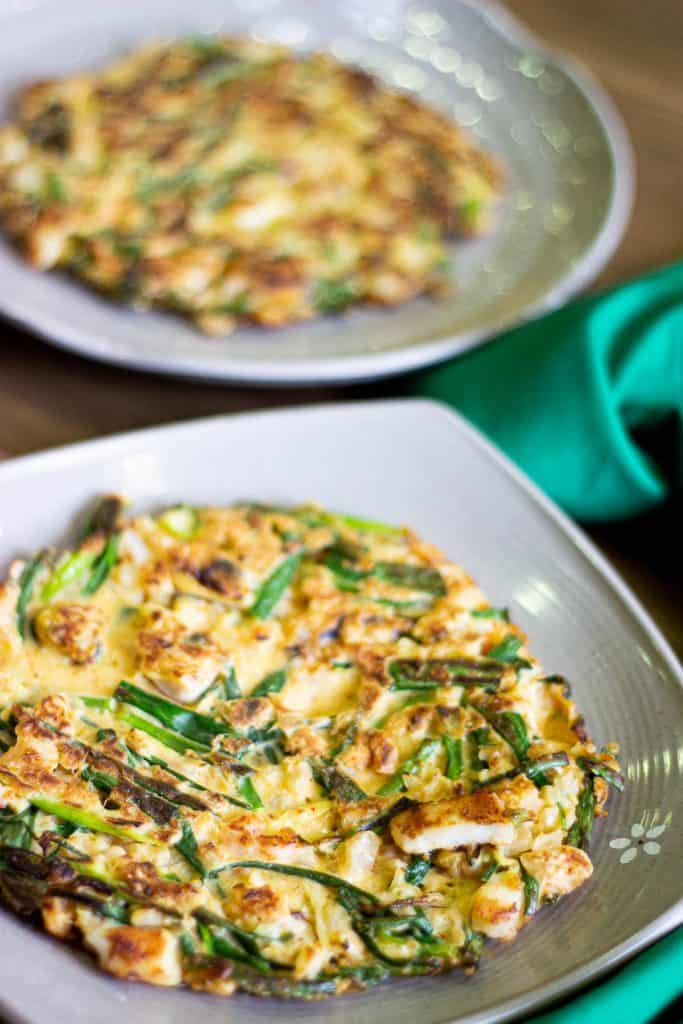
Why We Love This
Korean seafood pancakes are filling and spicy with a deliciously chewy texture and crispy edges.
They’re usually served as a snack or appetiser, but we love them as a healthy savoury dinner, similar to Japanese okonomiyaki but with classic Korean flavours.
This recipe is for two full sized pancakes to serve as dinner, but you can make them smaller suitable for an appetiser, or double the recipe to serve more people.
P.S. Love savoury pancakes? Try these Korean potato pancakes (gamja jeon) or Taiwanese crepes (dan bing) next!
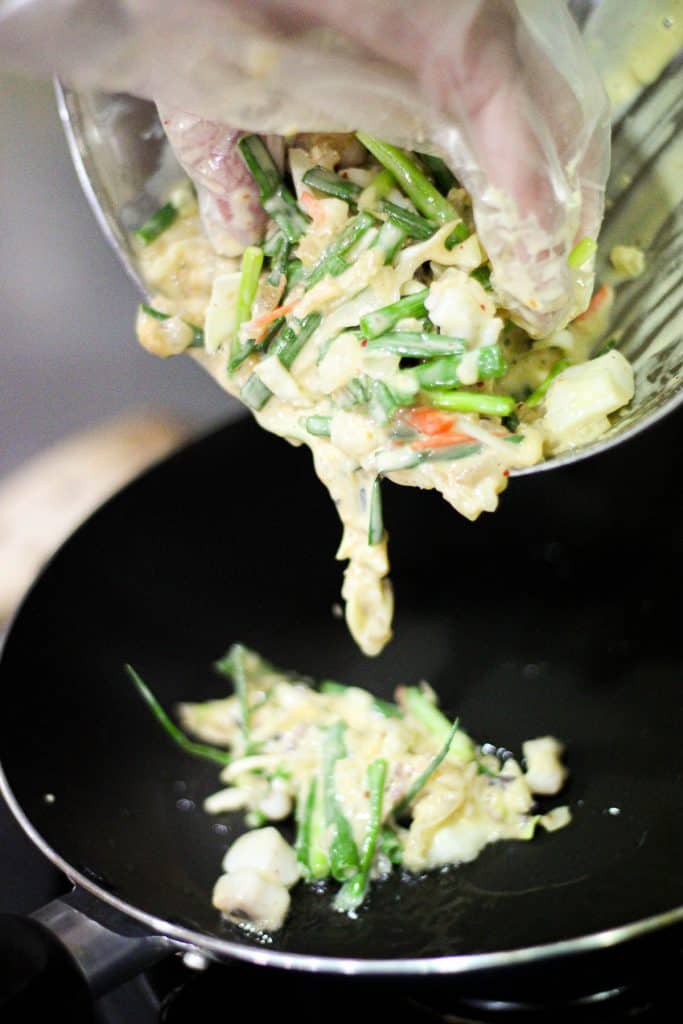
What is Haemul Pajeon?
Haemul Pajeon 해물파전 is a Korean seafood pancake. You’ll usually find it served as a street food dish in Korea, alongside dishes like tteokbokki (spicy rice cakes). But it’s also popular at restaurants with dakgalbi, and as an easy home-cooked meal.
So what is haemul pajeon? Let’s break it down a little further!
- Haemul (해물) means ‘seafood’. This dish is often made with a mix of seafoods like calamari, oysters, octopus etc.
- Pa (파) means ‘scallion’ (aka green onion or spring onion). There’s a similar type of Korean pancake called buchu jeon which is made with garlic chives instead of scallions.
- Jeon (전) means ‘pan fried or battered’, and in this case refers to the fried pancake.
These crispy Korean pancakes are also referred to as seafood scallion pancakes / green onion pancakes or buchimgae. There are slight differences in the cooking techniques and use of ingredients in pajeon vs buchimgae, but the names can sometimes be used interchangeably.
Just like Vietnamese banh xeo pancakes, they’re cooked in oil with some rice flour so they’re crispy rather than soft and fluffy like a sweet pancake.
P.S. For more epic Korean street food, try spicy tteokbokki stir fry or tteokkochi rice cake skewers!
Where We Learned This
We first learned how to make haemul pajeon from Ellie at F&C Korean Food & Culture Academy. She runs the amazing cooking classes where we also learned how to make traditional homemade kimchi and beef bulgogi.
What You’ll Need
Here’s a little info about the key ingredients for Korean pajeon pancakes:
- Korean Pancake Mix – Known as buchim garu, 부침가루, you can source Korean pancake mix from Asian grocers, buy it online or make a similar mix from the following:
- 1 cup of all-purpose flour
- 1 tbsp of rice flour – Note – Avoid using sweet rice flour as it will make the pancake mix a little ‘gummier’ rather than crispy. The most widely available brand is Erawan Thai rice flour. It comes in red and green varieties, so please use the red Erawan packet.
- 1 tbsp cornstarch
- ½ tsp baking powder
- ½ tsp garlic powder
- Salt and pepper
- Seafood – The easiest option is to look for a frozen seafood mix (which usually includes mussels, oysters, calamari, octopus, lobster, prawns/shrimp etc. Always defrost it first before making pajeon. You can also use a mix of your favourite seafoods, or leave it out completely if you don’t like seafood.
- Spring Onion – Substitute with flat Asian garlic chives for extra garlicky flavour.
- Cabbage – Napa cabbage is preferred for it’s slightly sweeter flavour and tender leaves, but you can use regular green cabbage if you prefer.
- Water – Always use ice water or cold water when making the batter, and aim for a thin runny consistency. This helps with crispiness similar to our recipe for Taiwanese dan bing crepes.
For the Korean Seafood Pancake Dipping Sauce:
We’ve included a simple blend of soy sauce, water, vinegar, and garlic in the recipe below. But you can also whip up simple gyoza dipping sauce for extra heat and flavour in a pinch!
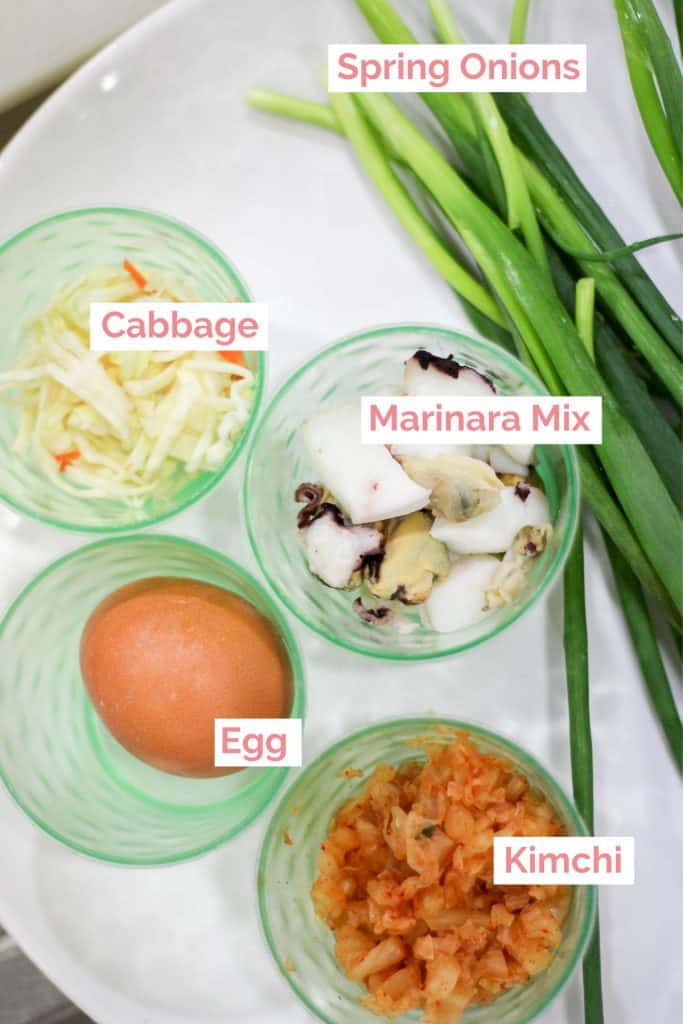
How to make Korean Seafood Pancakes:
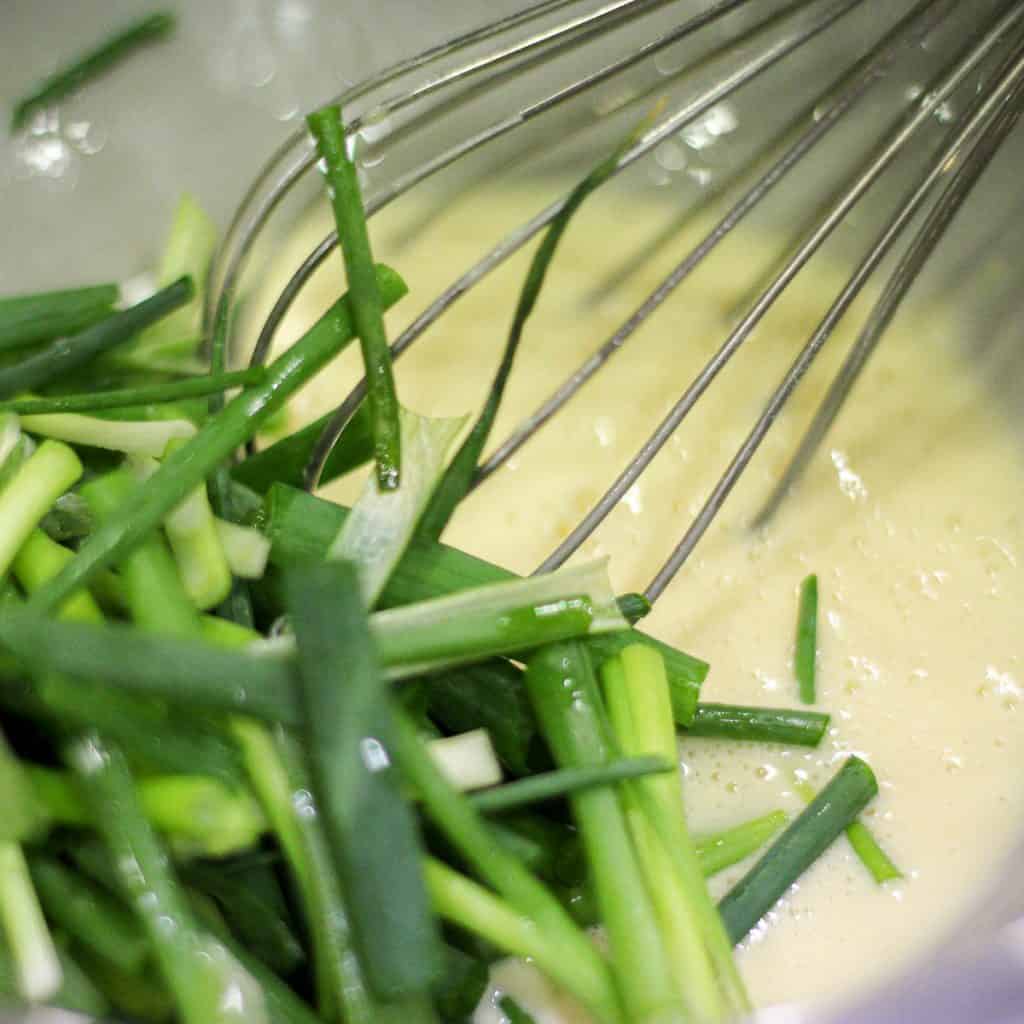
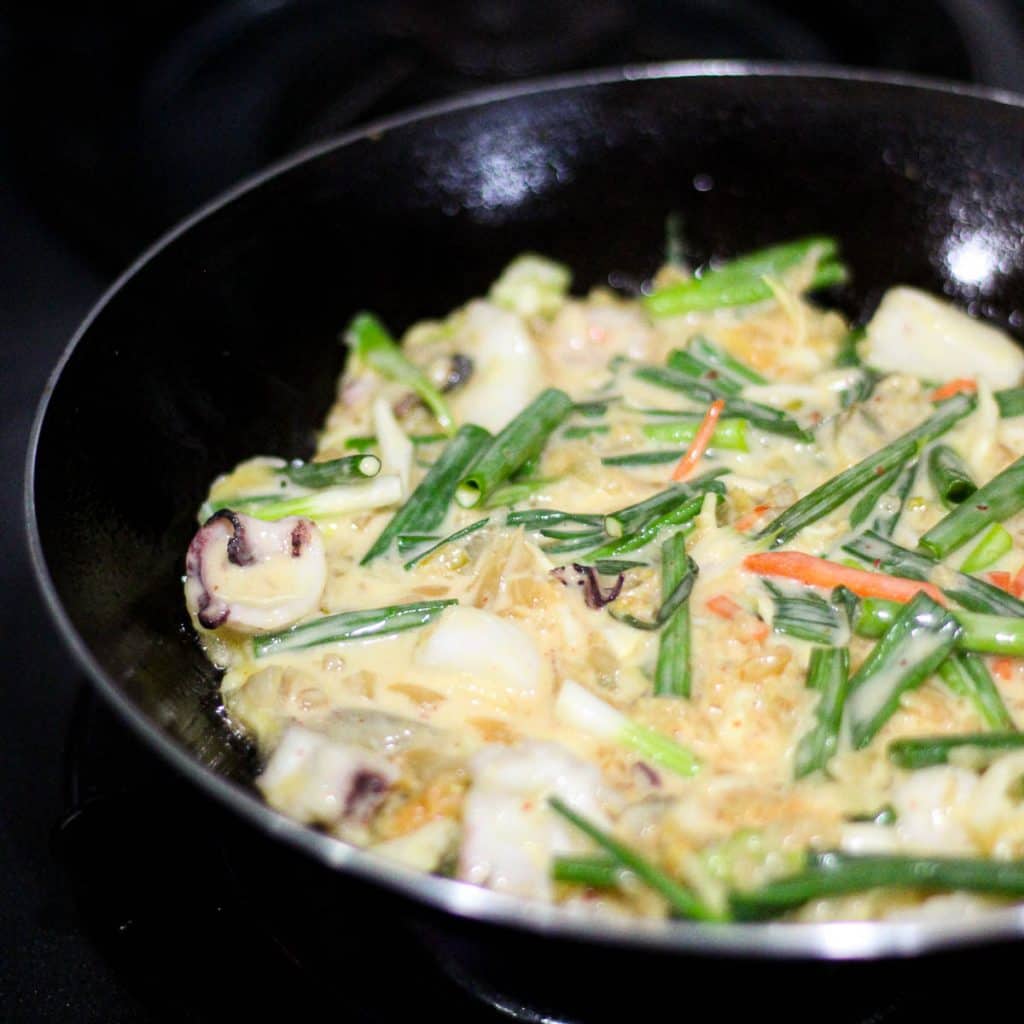
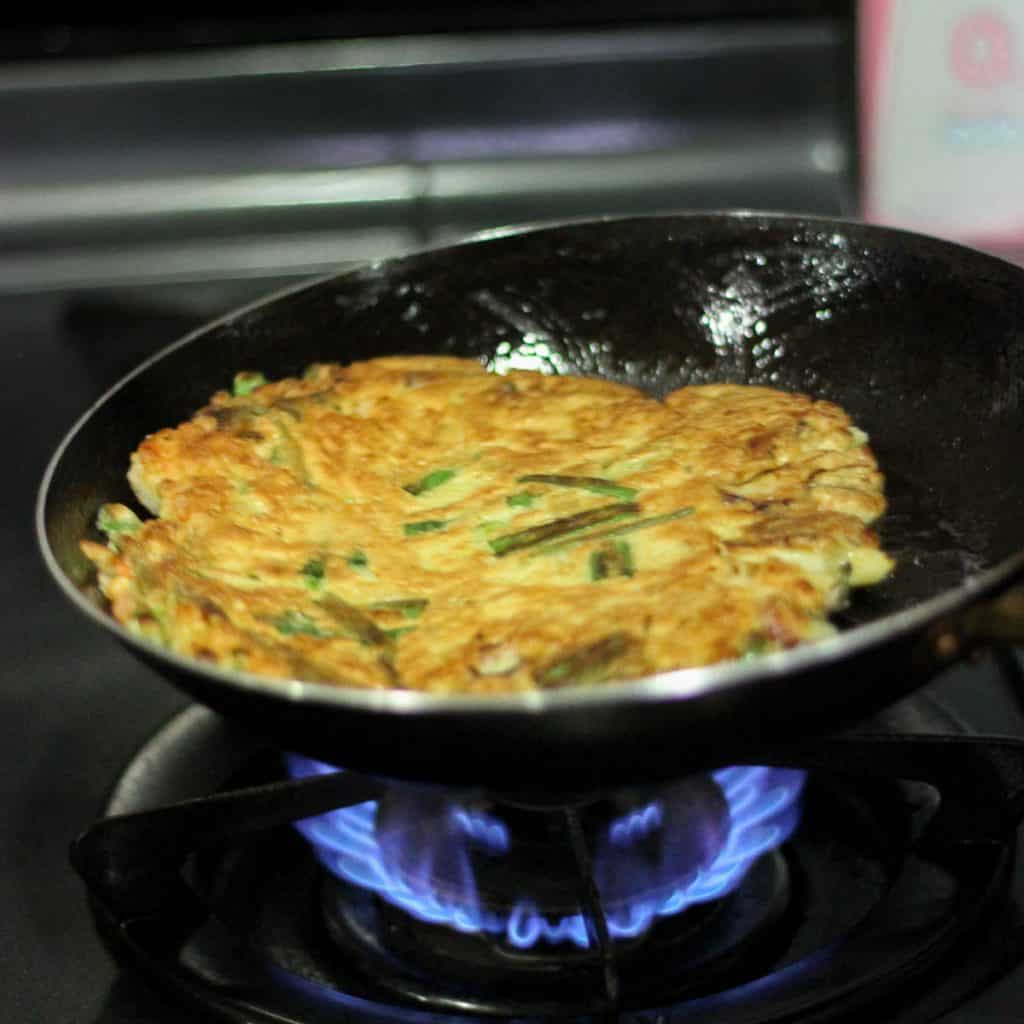
- Place the Korean pancake mix into a large bowl and top with the cold water and egg. Mix until batter is smooth. Add the seafood mix, spring onions, kimchi and cabbage to the batter and stir through until evenly mixed.
- Heat half the vegetable oil in a frying pan on high and then reduce heat to medium. Pour or ladle half the batter into the pan and press out to the edges. Cook until the bottom is golden brown, around 3-4 minutes.
- Flip the pancake and add a little more vegetable oil around the edges. Cook for another 3-4 minutes until the seafood has cooked through and the pancake is a delicious golden brown colour.
Wandercook’s Tips
- Drain All Ingredients – For extra crispy pancakes, ensure the seafood and chives are drained and patted dry with paper towel before you add them to the pancake mix. You could even use a vegetable spinner for this.
- Use Thin Slices – Trim the spring onions so they’ll fit the width of your pan. For spring onions with thicker stems, it’s a good idea to slice them in half first.
- Use Plenty of Oil – The tip to perfectly crispy Korean pancakes is to use heaps of oil. Heat plenty in the pan before you add the pancake mixture, then add more around the edges as you cook for golden brown and crispy pancakes.
- To Flip Like a Pro – Make sure the bottom is cooked and crispy before flipping, as this will make it easier to slide the spatula underneath. Using a non-stick frying pan makes this easier too.
FAQs
It’s usually served as a side dish or appetiser, and is a great starter before Korean BBQ. Round it out with steamed rice and homemade kimchi, pickled daikon radish or quick soy pickled onions on the side. They’d also pair perfectly with slow cooked Asian mushrooms or enoki beef rolls.
Slice into bite size pieces with chopsticks, or serve with a knife and fork. Don’t forget the dipping sauce!
Yes you can. Reheat them in the microwave in short bursts, or heat through in a frying pan which will help them stay a little crispier.
Variations & Substitutes
- Thick or Thin? – It’s up to you. Generally, the thinner you go, the crispier the pancakes will be. We like them to be a little chewy too though, so usually aim for them to be a little thicker and then add more oil around the outside for crispier edges.
- Add Heat – Add Korean chilli flakes into the batter (to taste), or garnish the finished pancakes with a few drops of rayu chilli oil or a sprinkling of shichimi chilli powder. Or serve with Cho-gochujang 초고추장, a spicy Korean dipping sauce made from vinegar and gochujang sweetened with sugar and/or honey.
- Make It Vegetarian – Leave out the seafood and just include the spring onions and kimchi, or add in some julienne sliced carrot and onion.
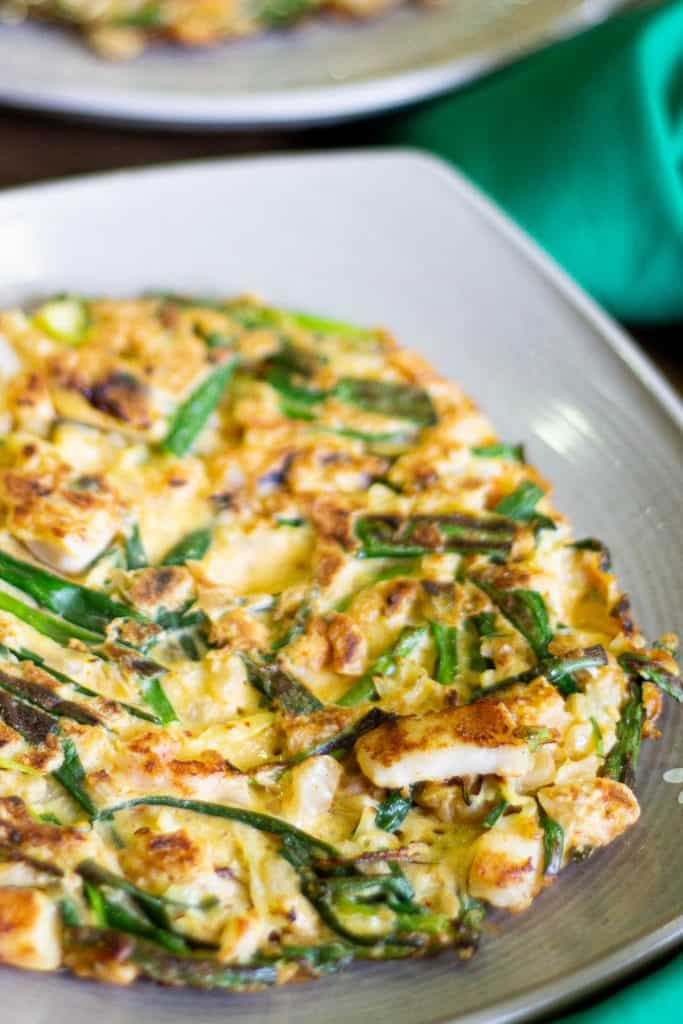
Looking for more mouthwatering Korean dishes to serve this with? Try these:
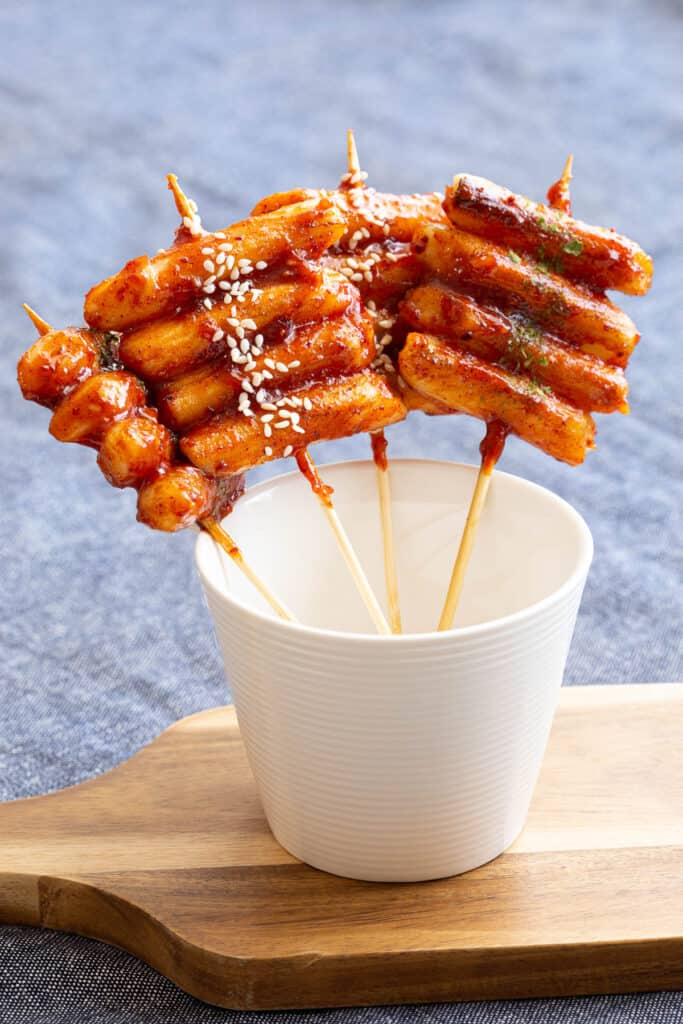
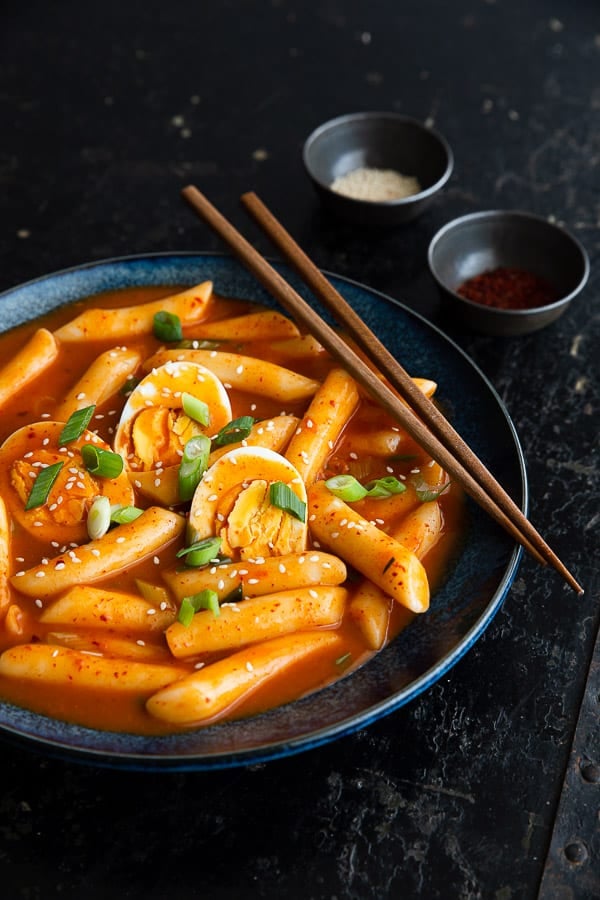
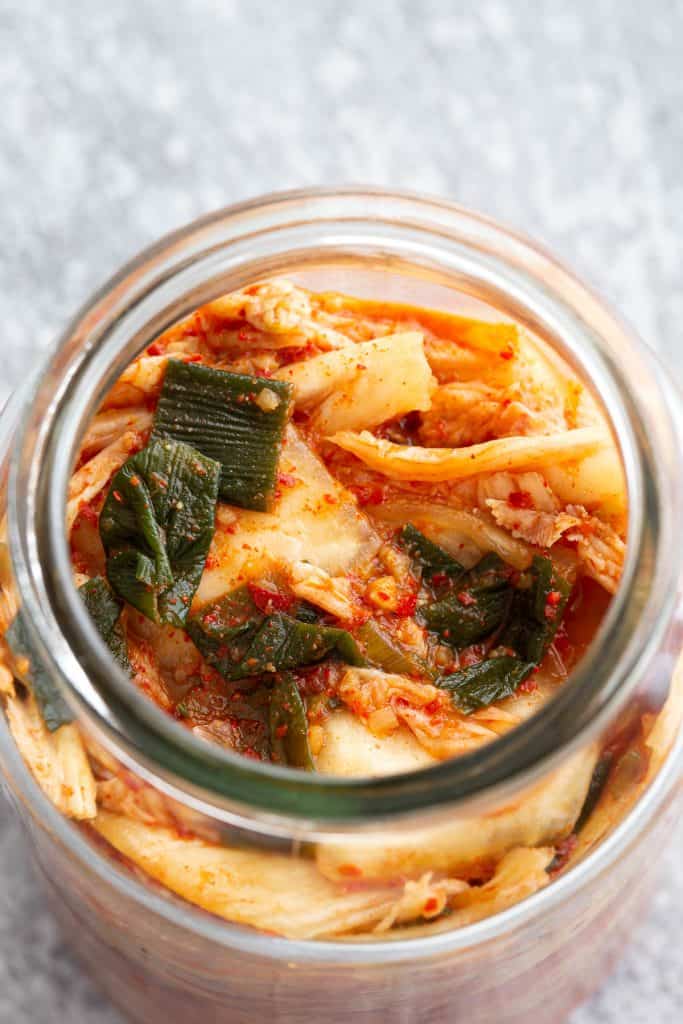
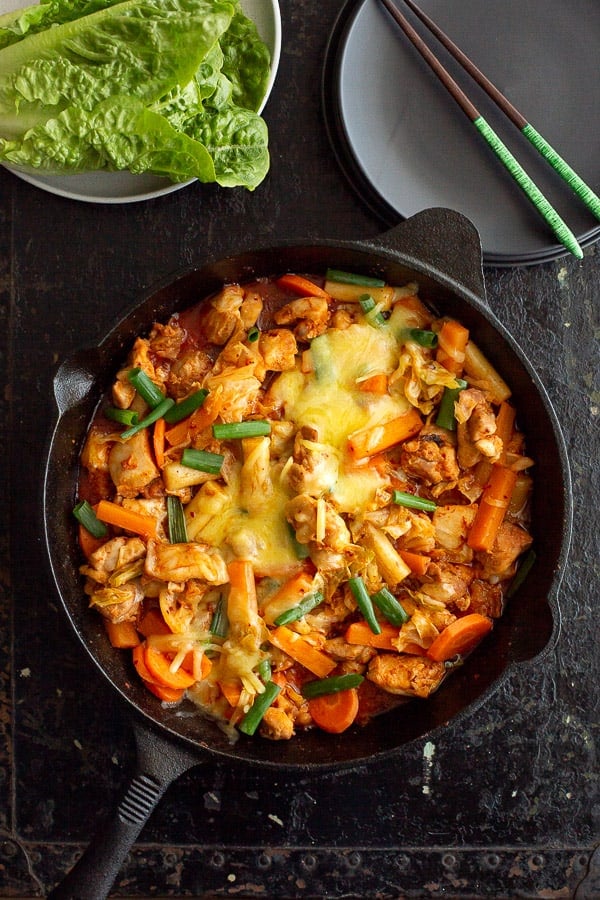
★ Did you make this recipe? Please leave a comment and a star rating below!
Equipment
Ingredients
- 1 cup Korean pancake mix store-bought, or see notes for a quick homemade version
- 1 cup cold water
- 1 egg
- 1 cup mixed seafood ie oysters, calamari, octopus etc. Thawed, drained and patted dry.
- 1 bunch spring onion sliced and chopped into approx 10cm lengths (substitute with Asian chives)
- ½ cup kimchi finely chopped
- ½ cup cabbage chopped
- 3-4 tbsp vegetable oil for cooking
For the Dipping Sauce
- 2 tbsp soy sauce
- 2 tbsp water
- 2 tbsp vinegar
- 1 tsp garlic
- ½ tsp Korean hot pepper flakes / gochugaru optional, sub with regular chilli powder
Instructions
For the Dipping Sauce:
- Mix the soy sauce, water, vinegar, minced garlic (and gochugaru / chilli powder if using) in a dipping bowl.2 tbsp soy sauce, 2 tbsp water, 2 tbsp vinegar, 1 tsp garlic, ½ tsp Korean hot pepper flakes / gochugaru
To Make the Korean Pancake Batter:
- Place the Korean pancake mix into a large bowl and top with the cold water and egg. Mix until batter is smooth. Add the seafood mix, spring onions, kimchi and cabbage to the batter and stir through until evenly mixed.1 cup Korean pancake mix, 1 cup cold water, 1 egg, 1 cup mixed seafood, 1 bunch spring onion, ½ cup kimchi, ½ cup cabbage
To Cook the Pancakes
- Heat half the vegetable oil in a frying pan on high and then reduce heat to medium. Pour or ladle half the batter into the pan and press out to the edges. Cook until the bottom is golden brown, around 3-4 minutes.3-4 tbsp vegetable oil
- Flip the pancake and add a little more vegetable oil around the edges. Cook for another 3-4 minutes until the seafood has cooked through and the pancake is a delicious golden brown colour.
- Repeat for the second pancake. Serve hot with the dipping sauce.
Recipe Notes
- Korean Pancake Mix – Known as buchim garu, 부침가루, you can source Korean pancake mix from Asian grocers, buy it online or make a similar mix from the following:
- 1 cup of all-purpose flour
- 1 tbsp of rice flour – Note – Avoid using sweet rice flour as it will make the pancake mix a little ‘gummier’ rather than crispy. The most widely available brand is Erawan Thai rice flour. It comes in red and green varieties, so please use the red Erawan packet.
- 1 tbsp cornstarch
- ½ tsp baking powder
- ½ tsp garlic powder
- Salt and pepper
- Seafood – The easiest option is to look for a frozen seafood mix (which usually includes mussels, oysters, calamari, octopus, lobster, prawns/shrimp etc. Always defrost it first before making pajeon. You can also use a mix of your favourite seafoods, or leave it out completely if you don’t like seafood.
- Spring Onion – Substitute with flat Asian garlic chives for extra garlicky flavour.
- Cabbage – Napa cabbage is preferred for it’s slightly sweeter flavour and tender leaves, but you can use regular green cabbage if you prefer.
- Water – Always use ice water or cold water when making the batter, and aim for a thin runny consistency. This helps with crispiness similar to our recipe for Taiwanese dan bing crepes.
- Thick or Thin Pancakes? – It’s up to you. Generally, the thinner you go, the crispier the pancakes will be. We like them to be a little chewy too though, so usually aim for them to be a little thicker and then add more oil around the outside for crispier edges.
- Add Heat – Add Korean chilli flakes into the batter (to taste), or garnish the finished pancakes with a few drops of rayu chilli oil or a sprinkling of shichimi chilli powder. Or serve with Cho-gochujang 초고추장, a spicy Korean dipping sauce made from vinegar and gochujang sweetened with sugar and/or honey.
- Make It Vegetarian – Leave out the seafood and just include the spring onions and kimchi, or add in some julienne sliced carrot and onion.
Nutrition
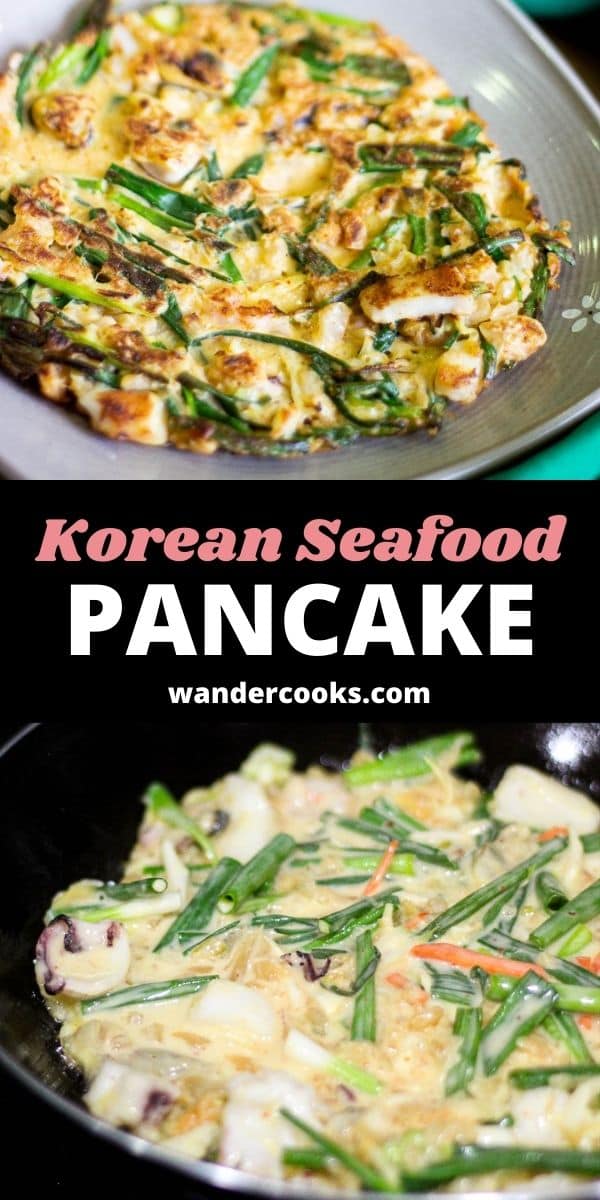

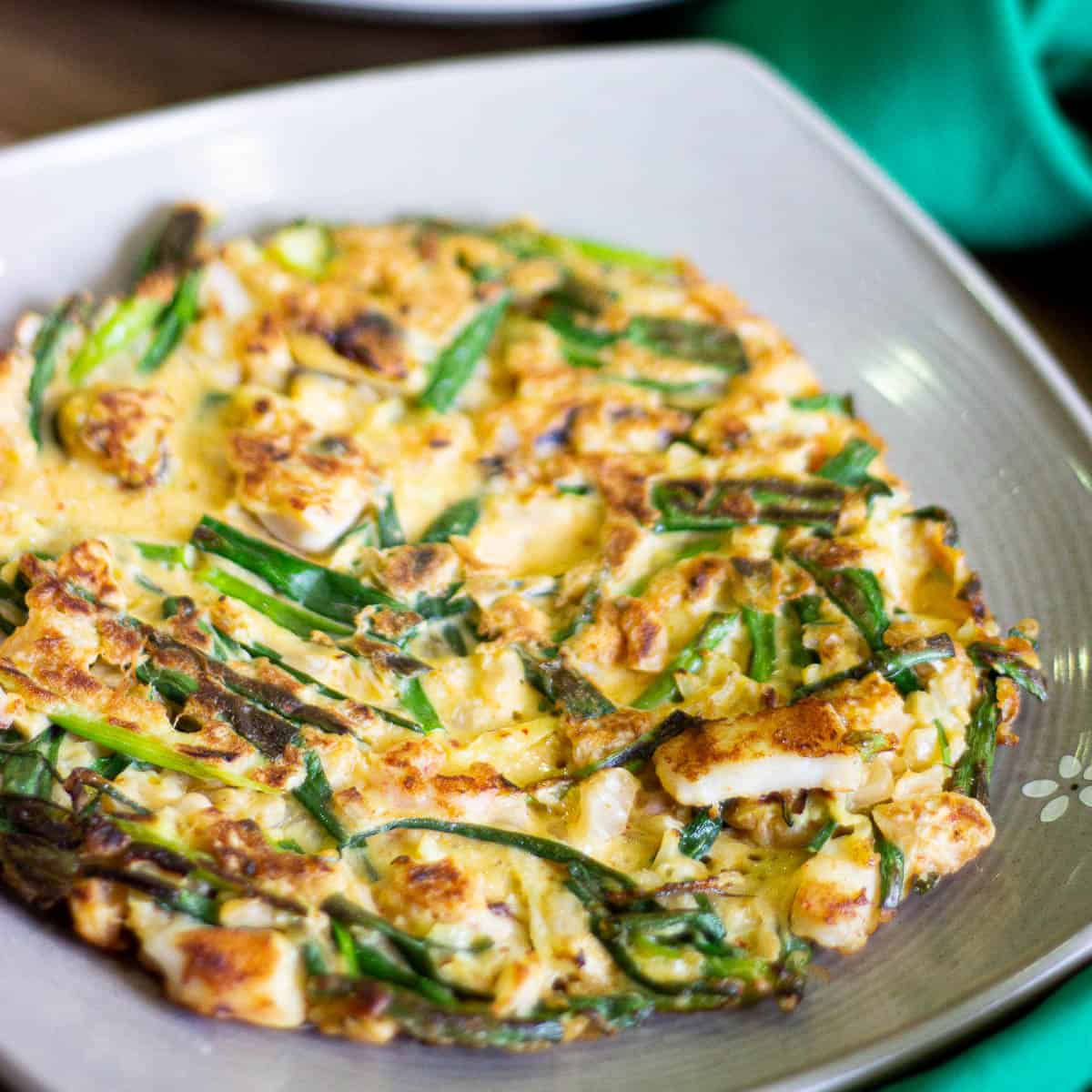


12 Comments
Georgina | Culinary Travels
09/03/2016 at 3:19 amThey look absolutely amazing. I’m loving all the flavours going on there.
Wandercooks
09/03/2016 at 9:14 amMm hmm! Crispy, spicy, savoury… what’s not to love?! 😀
AiPing | Curious Nut
08/03/2016 at 10:35 amCoolest pancake indeed. I love it to death. I’m so happy that I live just next to Korean Town here in LA. But I’ve recently learned how to make these babies at home so no need to eat out. SO GOOD! On a side note, get well soon Laura. And no, we both don’t do well flipping pancakes. I should be somewhat thankful my hubs love to do ONLY that portion of the cooking process. Tsk tsk.
Wandercooks
09/03/2016 at 8:39 amWell, sometimes we gotta take what we can get haha. In my case, I’m super glad that at least ONE of us is capable come flipping time. I’m heaps better now thanks AiPing! But eeeep, now I think it’s Sarah’s turn for the dreaded cold. Hopefully she can fight it off better than I did…
Noel
03/03/2016 at 11:28 amThere’s something about street food / food cart food that speaks to the soul – in every language!
Here’s hoping you get done being sicky soon.
stumbled and yummed
Wandercooks
04/03/2016 at 8:03 amExactly Noel! Laura’s on the mend thankfully, and just in time for our weekend getaway. There is much Balderdash to be played!
Tracy @ Served from Scratch
03/03/2016 at 11:13 amUm you kind of just blew my mind with this recipe. Pinning it to my Must Make board now!
Wandercooks
04/03/2016 at 8:00 amHahaha brilliant Tracy! I hope the taste is just as awesome 😀
michele
03/03/2016 at 10:57 amThese look absolutely delicious… Im going to try making the Korean Pancake mix as you suggested! Thanks 🙂 (you know, any excuse to avoid going back to the market!
Wandercooks
04/03/2016 at 8:00 amGreat idea, and totally agree! It’s so simple to make too 🙂
Sarah
03/03/2016 at 10:46 amGenius. Amazing. Delicious. I can’t wait to make this and am even more excited to eat this!!
Wandercooks
04/03/2016 at 7:59 amWoohoo! Thanks, Sarah. Hope you have fun flipping 😉